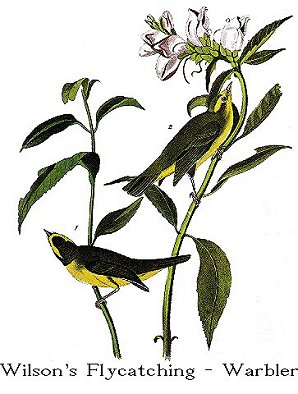
| Family VIII. SYLVICOLINAE. WOOD-WARBLERS. GENUS I. MYIODIOCTES, Aud. FLYCATCHING-WARBLER. |
Next >> |

Family |
WILSON'S FLYCATCHING-WARBLER. [Wilson's Warbler.] |
| Genus | MYIODIOCTES WILSONII, Bonap. [Wilsonia pusilla.] |
This species passes rapidly through the United States on its way to the
Northern Districts, where it breeds and spends the summer. WILSON saw only a
few specimens, which he met with in the lower parts of Delaware and New Jersey,
and supposed it to be an inhabitant of the Southern States, where, however, it
is never found in the summer months. It is not rare in the State of Maine, and
becomes more abundant the farther north we proceed. I found it in Labrador and
all the intermediate districts. It reaches that country early in June, and
returns southward by the middle of August.
It has all the habits of a true Flycatcher, feeding on small insects, which
it catches entirely on the wing, snapping its bill with a smart clicking sound.
It frequents the borders of the lakes, and such streams as are fringed with low
bushes, from which it is seen every moment sallying forth, pursuing its insect
prey for many yards at a time, and again throwing itself into its favourite
thickets.
The nest is placed on the extremity of a small horizontal branch, amongst
the thick foliage of dwarf firs, not more than from three to five feet from the
ground, and in the centre of the thickets of these trees so common in Labrador.
The materials of which it is composed are bits of dry moss and delicate pine
twins, agglutinated together and to the branches or leaves around it, and
beneath which it is suspended, with a lining of extremely fine and transparent
fibres. The greatest diameter does not exceed 31 inches, and the depth is not
more than 1 1/2. The eggs are four, dull white, sprinkled with reddish and
brown dots towards the larger end, where the markings form a circle, leaving the
extremity plain.
The parents show much uneasiness at the approach of any intruder, skipping
about and around among the twigs and in the air, snapping their bill, and
uttering a plaintive note. They raise only one brood in the season. The young
males shew their black cap as soon as they are fully fledged, and before their
departure to the south. The head of the young female is at first of the same
tint as the back, but I could not ascertain if they acquire their full colour
the first autumn.
I found these birds abundant in Newfoundland, but perceived that they had
already begun to migrate on the 20th of August; they were moving from bush to
bush, and seldom flew farther than thirty or forty yards at a time; yet when
crossing the arms of the Gulf of St. Lawrence, they are obliged to fly forty
miles or more without alighting. The little Winter Wren must perform the same
task, it being found in the same countries, to which some individuals travel
from the United States. I observed the Green Black-capped Flycatcher in
considerable numbers, in the northern parts of Maine, in October 1832, and
concluded that the individuals seen must have come from a great distance.
GREEN BLACK-CAPT FLYCATCHER, Muscicapa pusilla, Wils. Amer. Orn.,
vol. iii. p. 103.
SYLVIA WILSONII, Bonap. Syn., p. 86.
GREEN BLACK-CAPT WARBLER, Nutt. Man., vol. i. p. 149.
GREEN BLACK-CAPPED FLYCATCHER, Muscicapa Wilsonii, Aud. Orn. Biog.,
vol. ii. p. 148.
Wings short, the second and third quills longest and about equal, the first
much shorter than the fourth and a little longer than the fifth; tail even.
Back, rump, and upper tail-coverts yellowish-green; crown glossy bluish-black,
bordered on the forehead and over the eyes with a broad band of bright yellow,
of which colour are all the lower parts; wings and tail dusky brown, the
feathers margined with yellowish-green. Female similar to the male, but with
the black of the crown of much less extent. Young similar to the female,
without black on the head.
Male, 4 1/2, 6 3/4.
From Texas northward, Columbia river, and intervening regions. Not in the
Fur Countries. Rather rare. Migratory.
THE SNAKE'S HEAD.
CHELONE GLABRA, Willd., Sp. Pl., vol. iii. p. 225.
Pursch, Flor. Amer. Sept., vol. ii. p. 427.
--DIDYNAMIA ANGIOSPERMIA, Linn.--SCROPHULARINAE, Juss.
This plant grows on the banks of rivers and swamps, in the Middle and
Southern States. It is herbaceous and perennial, with opposite
lanceolate-oblong, acuminate, serrate leaves, and dense terminal spikes of pale
red flowers, not remarkable for beauty.
| Next >> |